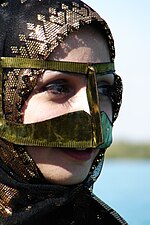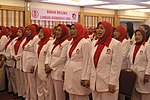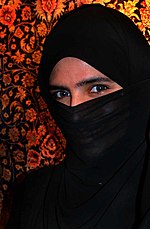Types of hijab: Difference between revisions
Appearance
Content deleted Content added
lead rewrite |
m ce |
||
| Line 1: | Line 1: | ||
{{Islamic culture}} |
{{Islamic culture}} |
||
This table of '''types of [[hijab]]''' describes terminologically distinguished styles of Islamic clothing commonly associated with the word ''hijab''. The Arabic word ''hijāb'' can be translated as "cover, wrap, curtain, veil, screen, partition", among other meanings.<ref name="El Guindi">{{cite web|last=El Guindi|first=Fadwa|title=Hijab|url=http://www.oxfordreference.com/view/10.1093/acref/9780195305135.001.0001/acref-9780195305135-e-0306|publisher=The Oxford Encyclopedia of the Islamic World|subscription=yes|author2=Sherifa Zahur|year= 2009}}</ref> In the Quran it refers to notions of separation, protection and covering in both literal and metaphorical senses.<ref name=EoQ>{{Cite encyclopedia|author=Siddiqui, Mona | year= 2006 | title=Veil |encyclopedia=Encyclopaedia of the Qurʾān|editor=Jane Dammen McAuliffe|url=http://referenceworks.brillonline.com/entries/encyclopaedia-of-the-quran/veil-EQSIM_00441|publisher=Brill|subscription=yes}}</ref> Subsequently, the word has evolved in meaning and usually denotes a Muslim woman's veil or the notion of separation between the sexes.<ref name=EoQ/> |
This table of '''types of [[hijab]]''' describes terminologically distinguished styles of Islamic clothing commonly associated with the word ''hijab''. The Arabic word ''hijāb'' can be translated as "cover, wrap, curtain, veil, screen, partition", among other meanings.<ref name="El Guindi">{{cite web|last=El Guindi|first=Fadwa|title=Hijab|url=http://www.oxfordreference.com/view/10.1093/acref/9780195305135.001.0001/acref-9780195305135-e-0306|publisher=The Oxford Encyclopedia of the Islamic World|subscription=yes|author2=Sherifa Zahur|year= 2009}}</ref> In the Quran it refers to notions of separation, protection and covering in both literal and metaphorical senses.<ref name=EoQ>{{Cite encyclopedia|author=Siddiqui, Mona | year= 2006 | title=Veil |encyclopedia=Encyclopaedia of the Qurʾān|editor=Jane Dammen McAuliffe|url=http://referenceworks.brillonline.com/entries/encyclopaedia-of-the-quran/veil-EQSIM_00441|publisher=Brill|subscription=yes}}</ref> Subsequently, the word has evolved in meaning and now usually denotes a Muslim woman's veil or the notion of separation between the sexes.<ref name=EoQ/> |
||
{| class="wikitable" |
{| class="wikitable" |
||
Revision as of 02:50, 23 August 2016
| Part of a series on |
| Islamic culture |
|---|
| Architecture |
| Art |
| Clothing |
| Holidays |
| Literature |
| Music |
| Theatre |
This table of types of hijab describes terminologically distinguished styles of Islamic clothing commonly associated with the word hijab. The Arabic word hijāb can be translated as "cover, wrap, curtain, veil, screen, partition", among other meanings.[1] In the Quran it refers to notions of separation, protection and covering in both literal and metaphorical senses.[2] Subsequently, the word has evolved in meaning and now usually denotes a Muslim woman's veil or the notion of separation between the sexes.[2]
| Najd Abaya | 
|
A type of outer garment from the Najd region of the Middle East which covers from the head to the feet. It is also becoming increasingly common amongst the conservative women of Pakistan. Traditional abayas are black, and may be either a large square of fabric draped from the shoulders or head, or a long black caftan. |
|---|---|---|
| Al-amira | 
|
A two-piece veil. It consists of a close fitting cap, usually made from cotton or polyester, and an accompanying tube-like scarf. |
| Bushiyya | A veil that is tied on at the forehead and falls to cover the entire face but has no cut-out for the eyes; instead, the fabric is sheer enough to be seen through. | |
| Bukhnuk بخنق | This is similar to khimār 2 (see below) but comes down just to the bosom. Sometimes called "Amira hijab" if it has embroidery at the edge. | |
| Eastern Arabia Batula برقع شرق الجزيرة العربية | 
|
Women wear it in United Arab Emirates, Oman, Qatar and Arabs of Southern Iran. This tradition has almost died out in the newer generations. Older women usually not younger than 50, and those living in rural areas can still be seen wearing them. |
| Burqa or chadari چادری | 
|
Traditional Central Asian style outer garment that covers the entire body and has a grille over the face that the woman looks through. Very similar in style and function to other Central Asian styles such as the paranja. |
| Chador | 
|
An Iranian traditional outer garment (also exist in Turkey) that covers the head and body and is a full-length semicircle of fabric but comes down to the ground. Does not have slits for the hands and is held shut with the hands, teeth or simply wrapped under the arms. |
| Dupatta | 
|
Common Pakistani, Punjabi and Indian garment, a large colored cloth made of a lightweight fabric that covers the head and shoulders. Usually sold in a three-piece set with colors or patterns matching the pants and shirts of a Salwar kameez. Worn by Hindus as well. |
| Hijāb (1) حجاب | generic | “What does hijaab mean?” The most likely answers will vary from that of a woman wearing a head scarf, a veil or a loose outer garment. Hijaab, however, in the sense that it has been used in the Qur'an and Hadith, has a far wider meaning. Actually, hijaab is a set of laws governing the interaction between males and females, with rules that must be abided by both. In the minds of most people -even Arabs- that meaning has been lost due to forgetfulness or religious complacency. For the context of this article however, we will say, as most people do these days, that Hijab simply means a reference to the entire modest dress of the Muslim woman. |
| Hijāb (2) | generic | The headscarf; this is properly referred to as a khimār, plural khumur. |
| Hijāb (3) | A type of head covering that is a square of fabric folded into a triangle then placed over the head and fastened under the chin; this is probably the most common current style, especially in Western countries. See explanation in the article on Hijāb | |
| Jilbāb (1) جلباب | generic | The term used in the Qur'an (Suratu l-Ahzāb, āya 59) to refer to the outer garment. In Indonesia, the term jilbab refers exclusively to the head-covering. |
| Jilbāb (2) | File:Munaaaa.jpg | A type of outer garment that looks like a long raincoat or trenchcoat. |
| Kerudung | 
|
Although similar to the Malaysian tudong (below), the modern Indonesian kerudung usually includes a stiff visor above the eyes. |
| Khimār (1) خمار | generic | The term used in the Qur'an (Suratu n-Nūr, āya 31) to refer to the headscarf; the word "hijāb" is more commonly used with this meaning. |
| Khimār (2) | Most commonly, a circular head covering with a hole cut out for the face, which usually comes down to the waist. Note the variations buknuk and chador above, which are the same style but different lengths. | |
| Kimeshek (kk:Кимешек) | 
|
Traditional headgear of married woman in Kazakhstan, Karakalpakstan and Kyrgyzstan. (unmarried women wear the Kalpak, and young girls wear the taqia). |
| Mukena | 
|
An Indonesian hijab worn almost exclusively for praying. It is fastened around the head with two strings. Colours are usually white or pastel. |
| Niqaab نقاب | 
|
A veil that covers the face and entire head but with a place cut out for the eyes. |
| Niqaab (2) | 
|
A veil that is tied on at the bridge of the nose and falls to cover the lower face. Also called "half niqab". |
| Paranja | 
|
A Central Asian traditional outer garment that covers the head and body, heavy in weight and made from horsehair. Especially prevalent in Uzbek and Tajik societies and very similar in style and function to other Central Asian regional styles such as the Afghan chadari. |
| Selendang | 
|
In Indonesia, a multi-purpose shoulder sash that can be tied around the shoulders to carry infants and groceries, or draped over the head. |
| Shayla | 
|
Long, rectangular scarf, wrapped around the head and tucked or pinned in place at the shoulders. Popular in the Gulf region.[3] |
| Tudung or Kerudung | 
|
Headscarf worn in Malaysia and Indonesia. In Indonesia, the term kerudung is much more common. |
See also
External links
| Part of a series on |
| Islamic female dress |
|---|
| Types |
| Practice and law by country |
| Concepts |
| Other |
- ^ El Guindi, Fadwa; Sherifa Zahur (2009). "Hijab". The Oxford Encyclopedia of the Islamic World.
{{cite web}}: Unknown parameter|subscription=ignored (|url-access=suggested) (help) - ^ a b Siddiqui, Mona (2006). "Veil". In Jane Dammen McAuliffe (ed.). Encyclopaedia of the Qurʾān. Brill.
{{cite encyclopedia}}: Unknown parameter|subscription=ignored (|url-access=suggested) (help) - ^ BBC, In graphics: Muslim veils